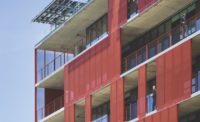Since the launch of LEED for Existing Buildings (EB) three years ago, the U.S. Green Building Council (USGBC) has seen modest participation in its program focused on encouraging best practices in the ongoing operations and maintenance of already constructed buildings. So far, about 400 buildings have been registered with the council, while approximately 75 projects have achieved certification.


According to council estimates, fewer than five of these EB-certified projects had been previously certified under the popular LEED for New Construction (NC) rating system. Uptake of dual certification has been slow even though EB proponents say that the program can help owners maximize performance, even for a building designed to operate at a high level. An NC building without EB certification “is a little like a car without a maintenance plan,” says Michael Arny, president of consulting firm Leonardo Academy and former chair of the council’s LEED EB committee.
For a building already NC certified, few if any infrastructure changes would be needed to achieve EB certification. Instead, EB requires performance testing and tracking of resource use. “It should be possible to certify an NC building without additional capital expenditures,” says the USGBC’s Doug Gatlin, who oversees the EB program.
One NC project seeking EB certification is the Polshek Partnership–designed William J. Clinton Presidential Center, in Little Rock, completed in 2004 and certified at the Silver level. Some of the measures the center has recently instituted include the addition of metering devices to monitor energy and water use, replacement of cleaning supplies with environmentally benign products, installation of mulching blades on lawn mowers, and the creation of a recycling and waste-stream-management program. “Most of the credits are low- or no-cost,” says Debbie Shock, director of operations and facilities for the William J. Clinton Foundation.
Typical additional expenses incurred for EB certification include retrocommissioning fees, consultants’ fees, and the cost of staff time for submittal preparation. Fees for review of an application by the USGBC are based on a building’s size and range from $1,250 to $12,500.
Participants say documentation requirements can be demanding, though prior LEED experience helps. “We understand the process, but for others, it might be a lot of paperwork,” says Michael Gubbins, director of residential management for the developer Albanese Organization. Gubbins’s team is applying for EB certification of the Solaire in New York City. The 293-unit apartment building, designed by Pelli Clarke Pelli Architects, achieved Gold NC certification after its opening in 2003.
Owners can expect to realize savings from EB program participation, advocates say. After first earning a LEED NC Silver rating for its Brengel Technology Center in Milwaukee, Johnson Controls recertified the 130,000-square-foot building under the EB program at the Gold level three years later. EB implementation, including installation of expanded building-systems monitoring devices, modification of landscape practices, and replacement of light-fixture lamps, cost $27,250, according to a case study of the project by the USGBC. However, these measures save Johnson Controls $27,780 annually in utility and overall operational costs, says the study.
Greater savings could be possible after a revamped EB is launched this month. The council has focused the updated rating tool, to be called LEED EB Version 2008, even more narrowly on operations, removing some credits pertinent only to new construction. It places more emphasis on energy use and water efficiency, and is less prescriptive than the current version. For example, instead of awarding a credit for installation of a bike rack, projects can earn points for occupants’ use of alternative transportation. Says Gatlin, “The new version is about performance rather than technology.”






